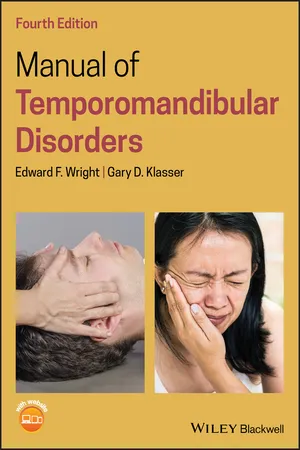Temporomandibular disorder (TMD) generally involves many structures with varying degrees of pain intensity and dysfunction. During the initial evaluation, the involved structures need to be identified and the degree to which each contributes to the patient’s symptoms need to be categorized. Additionally, the contributing factors and symptom patterns help to identify which therapies will be the most beneficial for each patient [1].
Hence, the goals of the initial examination are to identify: a patient’s primary diagnosis; secondary, tertiary, and so on, diagnoses; contributing factors; and symptom patterns.
Focal Point
The goals of the initial examination are to identify: a patient’s primary diagnosis; secondary, tertiary, and so on, diagnoses; contributing factors; and symptom patterns.
The primary diagnosis is the diagnosis for the disorder most responsible for a patient’s chief complaint. This diagnosis can be of TMD origin (e.g. myalgia, TMJ arthralgia, or temporomandibular joint [TMJ] disc displacement without reduction with limited opening) or from a different source (e.g. pulpitis, sinusitis, or cervicogenic headache) [2].
Focal Point
The primary diagnosis is the diagnosis for the disorder most responsible for a patient’s chief complaint.
Secondary diagnosis, tertiary diagnosis, and so on, are other TMD diagnoses that generally contribute to the TMD symptoms. Typically, the primary diagnosis will be of TMD origin (e.g. myalgia), and the secondary and tertiary diagnoses will be other TMD diagnoses (e.g. TMJ arthralgia and TMJ disc displacement with reduction) that contribute to a patient’s chief complaint. When a non‐TMD (e.g. fibromyalgia) contributes to a TMD primary diagnosis, the non‐TMD disorder is designated as a contributing factor to the TMD diagnosis and not as secondary or tertiary diagnosis [2].
Focal Point
Secondary, tertiary, and so on, diagnoses are additional TMD diagnoses that contribute to the TMD symptoms.
During the initial exam, we also attempt to identify the perpetuating contributing factors. These are elements that perpetuate the disorder (not allowing it to resolve), for example, sleep parafunctional behaviors, gum chewing, awake clenching, stress, or neck pain [1–3]. Additionally, we attempt to identify the symptom patterns that include the period of the day in which the symptoms occur or are most intense (e.g. worse upon awaking) and the location pattern (e.g. begins in the neck and then moves to the jaw).
Focal Point
Perpetuating contributing factors are elements that are not allowing the disorder to resolve, for example, sleep parafunctional behaviors, gum chewing, awake clenching, stress, or poor posture.
Symptom patterns include the period of the day in which the symptoms occur or are most intense (e.g. worse upon awaking) and the location pattern (e.g. begins in the neck and then moves to the jaw).
The following non‐TMD examples may help you better understand how these terms are used. A patient complains to her physician about wrist pain. Through palpation of her wrist area, her physician determines the primary cause for her pain is the tenderness within the wrist joint (its diagnosis would be the primary diagnosis). Her physician also finds the muscles around the wrist are painful but less tender than the wrist joint (the muscle diagnosis would be the secondary diagnosis). The physician also knows the patient has a systemic arthritic condition, which he suspects makes her more susceptible to developing the wrist pain (a contributing factor).
By asking questions, the physician finds that this pain only occurs upon awakening and lasts half an hour; this suggests that wrist activity occurring during sleep is the major contributing factor. Her physician may decide the best initial therapy is to prescribe her a wrist splint to wear during sleep to ensure the wrist stays in a neutral position.
In a second example, the patient has the identical diagnosis and a systemic arthritic condition but has a different symptom pattern. In this example, the wrist pain consistently begins approximately half an hour after she starts using the computer and continues as long as she uses the computer, suggesting that computer use is the major contributing factor for her wrist pain.
To treat the wrist pain, her physician decides the best initial approach is to (i) refer her to a therapist to teach her about computer keyboard and mouse ergonomics, and (ii) prescribe her a nonsteroidal anti‐inflammatory drug (NSAID) short term, to provide her with temporary pain relief until her wrist responds to the computer keyboard and mouse ergonomic instructions. In both situations, the physician decides to not escalate therapy for the systemic arthritic condition because he believes the local therapies will resolve the pain complaint.
In spite of having the identical diagnoses and systemic contributor, the preferred therapy changed with different contributing factors.
The initial TMD evaluation involves interviewing the patient about his or her symptoms, potential contributing factors, and potential non‐TMD. The interview most influences the pa...








